A striking example of seaside architecture, this grade II listed building (the former dilapidated pavilion) had been one of the most at-risk Victorian/Edwardian buildings in the land. Built as a concert hall/assembly rooms and designed by architect Stanley Davenport Adshead, it was based on the style of a Robert Adam orangery. The interior is said to be derived from the Little Theatre at Versailles and was simplified in the 1930s. After being a nightclub, then casino, it closed in 2008.
A photograph, illustration and text about the original Royal Pavilion café.
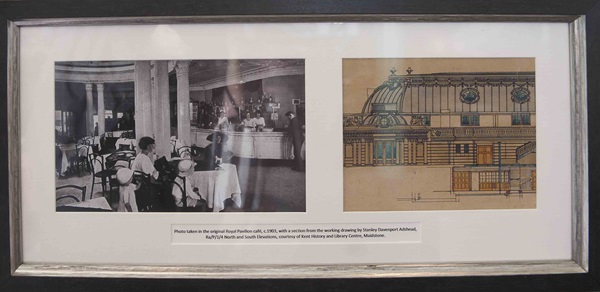
The text reads: Photo taken in the original Royal Pavilion café, c1903, with a section from the working drawing by Stanley Davenport Adshead, Ra/P/1/4 North and South Elevations, courtesy of Kent History and Library Centre, Maidstone.
A print, photographs and text about Robert Adam.
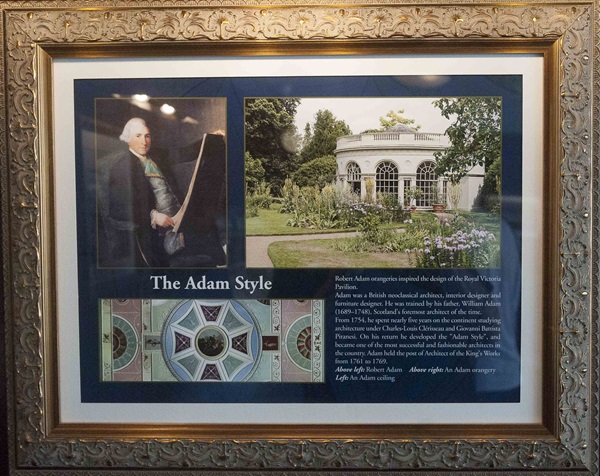
The text reads: Robert Adam orangeries inspired the design of the Royal Victoria Pavilion.
Adam was a British neoclassical architect, interior designer and furniture designer. He was trained by his father, William Adam (1689- 1748), Scotland’s foremost architect of the time.
From 1754, he spent nearly five years on the continent studying architecture under Charles-Louis Clerisseau and Giovanni Battista Piranesi. On his return he developed the “Adam Style”, and became one of the most successful and fashionable architects in the country. Adam held the post of Architect of the King’s Works from 1761 to 1769.
Above left: Robert Adam Above right: An Adam orangery
Left: An Adam ceiling
Text about Robert Adam and an example of his work.
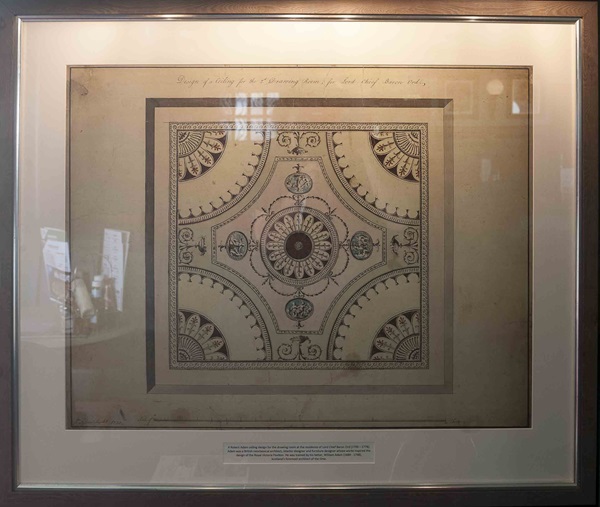
The text reads: A Robert Adam ceiling design for the drawing room at the residence of the Lord Chief Baron Ord (1700-1778). Adam was a British neoclassical architect, interior designer and furniture designer whose works inspired the design of the Royal Victoria Pavilion. He was trained by his father, William Adam (1689-1748), Scotland’s foremost architect of the time.
An original poster from a 1963 edition of What’s on, Thanet, advertising the popular Eddie Payne Show regularly held at the Pavilion.
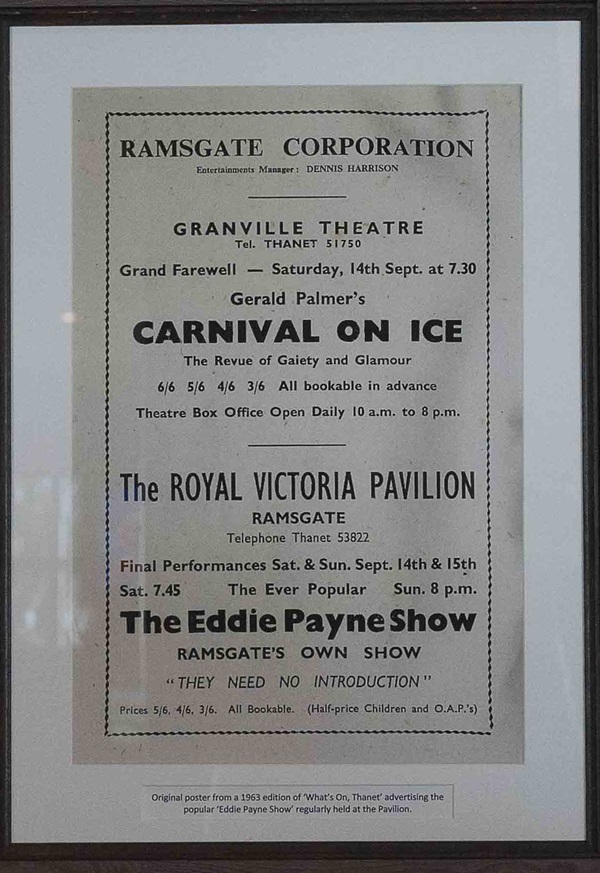
Photographs and text about the art on the floor.
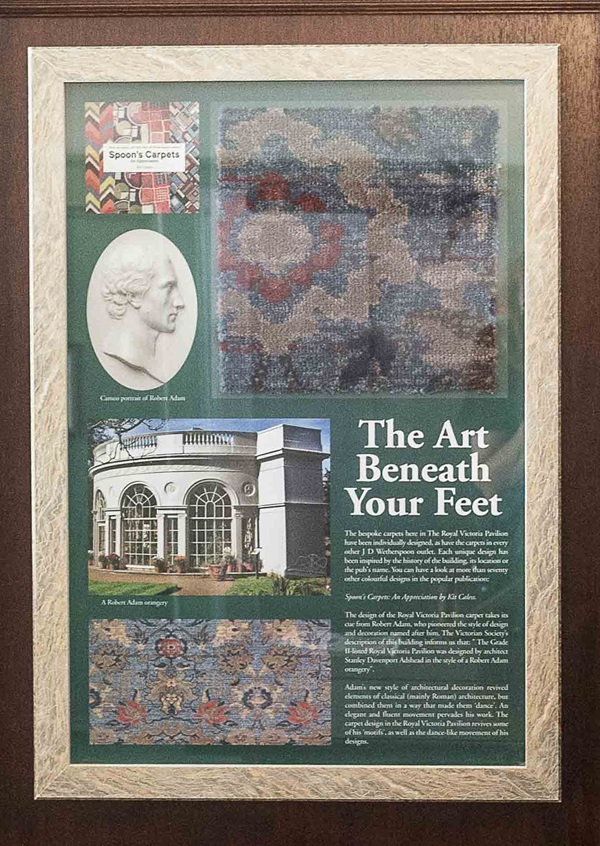
The text reads: The bespoke carpets here in The Royal Victoria Pavilion have been individually designed, as have the carpets in every other J D Wetherspoon outlet. Each unique design has been inspired by the history of the building, its location or pub’s name. You can have a look at more than seventy other colourful designs in the popular publication:
Spoon’s Carpets: An Appreciation by Kit Caless
The design of the Royal Victoria Pavilion carpet takes its cue from Robert Adam, who pioneered the style of design and decoration of this building informs us that: “The Grade II-listed Royal Victoria Pavilion was designed by architect Stanley Davenport Adshead in the style of a Robert Adam orangery".
Adam’s new style of architectural decoration revived elements of classical (mainly Roman) architecture, but combined them in a way that made them ‘dance’. An elegant and fluent movement pervades his work. The carpet design in the Royal Victoria Pavilion revives some of his ‘motifs’, as well as the dance-like movement of his designs.
A photograph, prints and text about the Little Theatre.
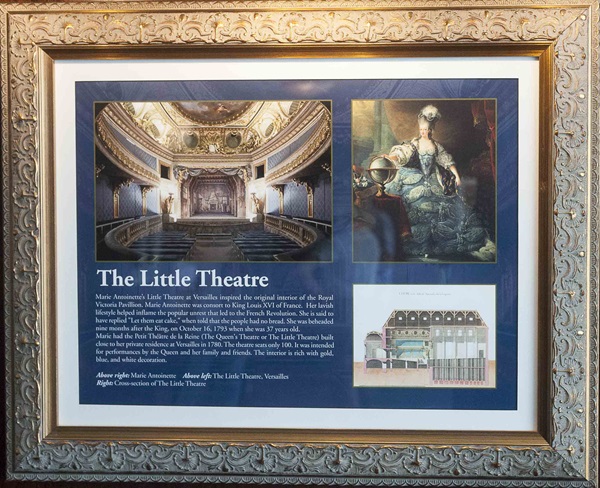
The text reads: Marie Antoinette’s Little Theatre at Versailles inspired the original interior of the Royal Victoria Pavilion. Marie Antoinette was consort to King Louis XVI of France. Her lavish lifestyle helped inflame the popular unrest that led to the French Revolution. She is said to have replied “Let them eat cake,” when told that the people had no bread. She was beheaded nine months after the King, on October 16, 1793 when she was 37 years old.
Marie had the Petit Theatre de la Reine (The Queen’s Theatre or The Little Theatre) built close to her private residence at Versailles in 1780. The Theatre sets only 100. It was intended for performances by the Queen and her family and friends. The interior is rich with gold, blue, and white decoration.
Above right: Marie Antoinette
Above left: The Little Theatre, Versailles
Right: Cross-section of The Little Theatre.
A photograph of the Theatre of Queen Marie Antoinette, Petit Trianon, Palace of Versailles.
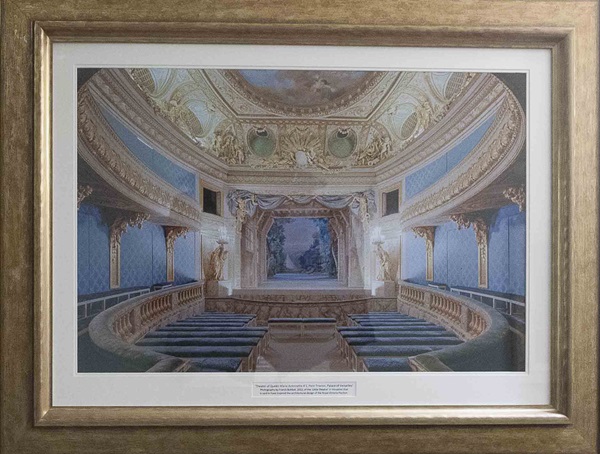
Photography by Frank Bohbot, 2012, of the Little Theatre in Versailles that is said to have inspired the architectural design of the Royal Victoria Pavilion.
A photograph of Stanley Davenport Adshead, architect of the Royal Victoria Pavilion.
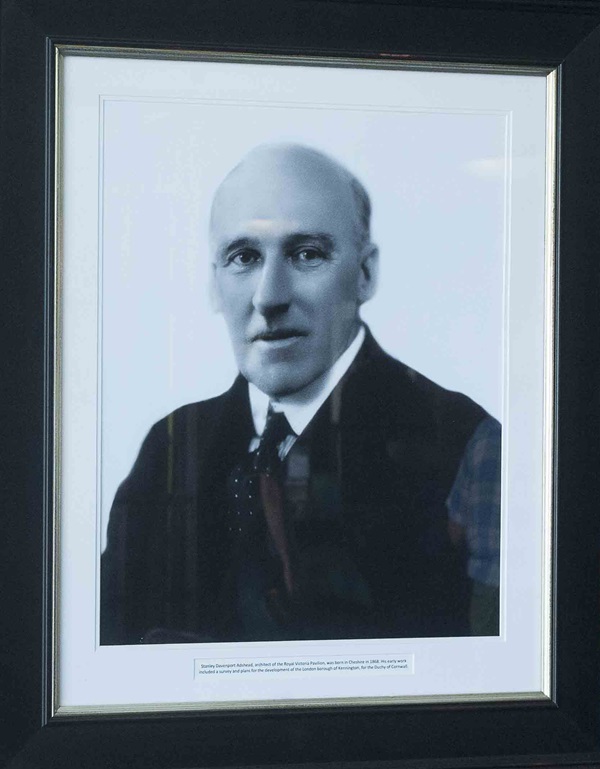
He was born in 1868. His early work included survey and plans for the development of the London borough of Kennington, for the Duchy of Cornwall.
A working drawing for the Royal Victoria Pavilion for the Corporation of Ramsgate, by Stanley Davenport Adshead.
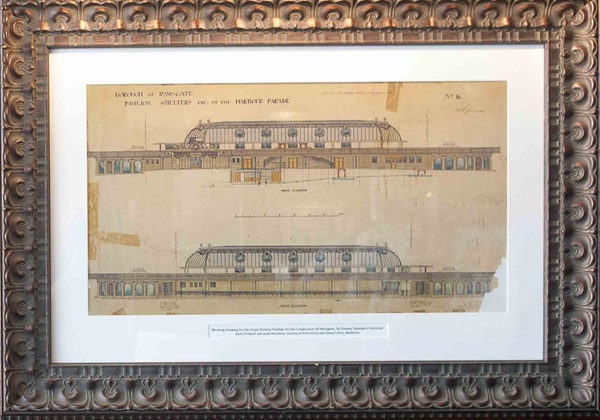
Courtesy of Kent History and Library Centre, Maidstone.
An illustration of the elevation for The Royal Pavilion showing part of the elevation opposite, looking out towards the sea, 1903.
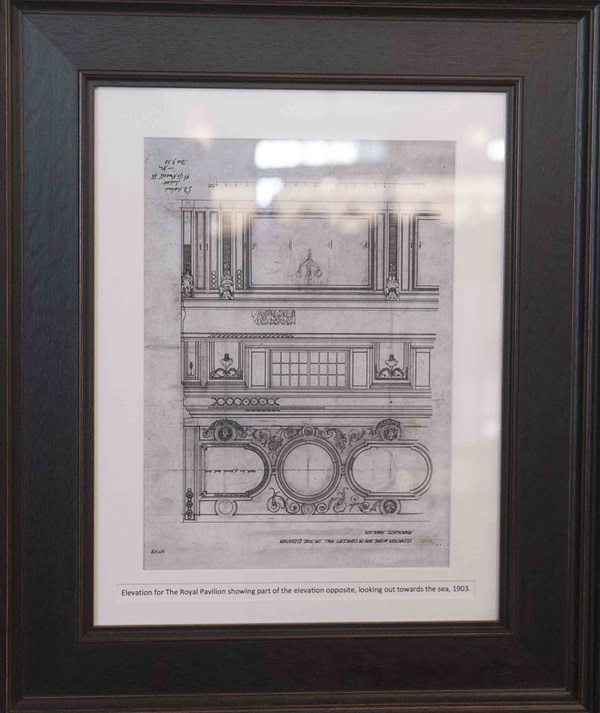
An illustration of Ramsgate boats, c1845, by Thomas Sewell Robins (1810-1880), British maritime painter, lectured by JMW Turner.
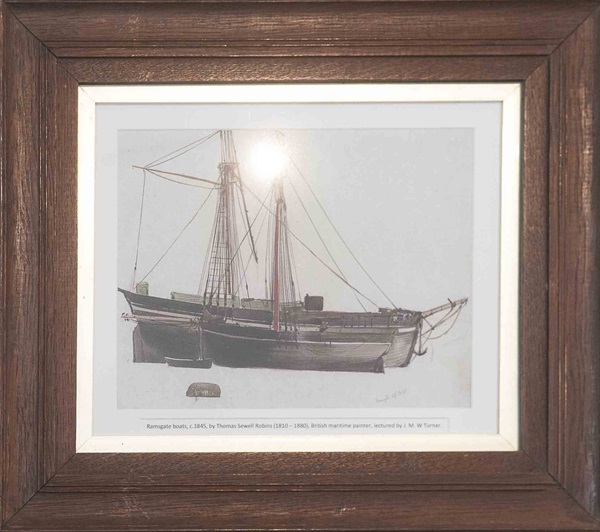
A photograph of Royal Pavilion and Harbour, pictured here c1906 with the east and west piers encircling the harbour.
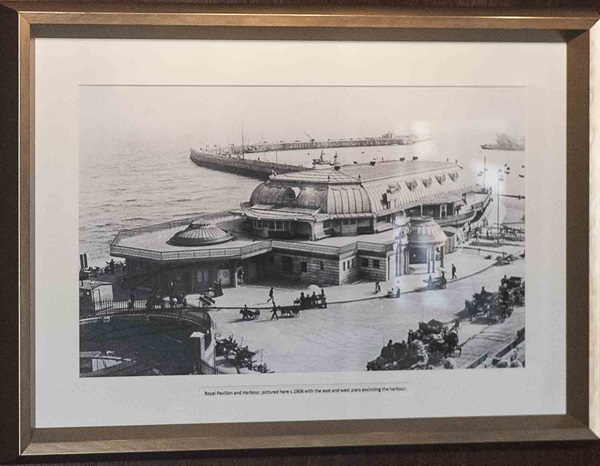
Photographs and text about Al Tabor and his band.
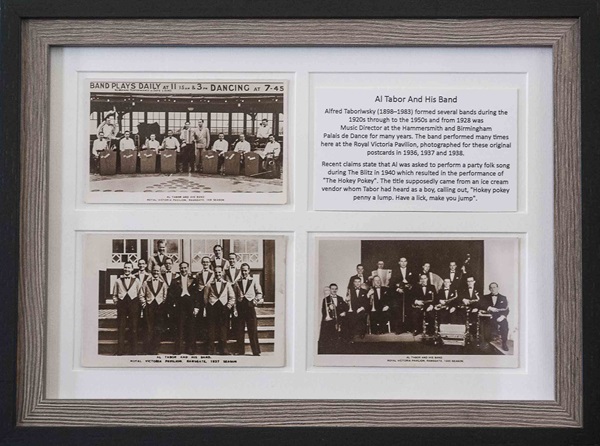
The text reads: Alfred Taboriwsky (1898-1983) formed several bands during the 1920s though to the1950s and from 1928 was Music Director at the Hammersmith and Birmingham Palais de Dance for many years. The band performed many times here at the Royal Victoria Pavilion, photographed for these original postcards in 1936, 1937 and 1938.
Recent claims state that Al was asked to perform a party folk song during The Blitz in 1940 which resulted in the performance of “The Hockey Pockey”. The title supposedly came from an ice cream vendor whom Tabor had heard as a boy, calling out, “Hockey pokey penny a lump. Have a lick, make you jump”.
An engraving and text about the sands and railway station, dated 1868.
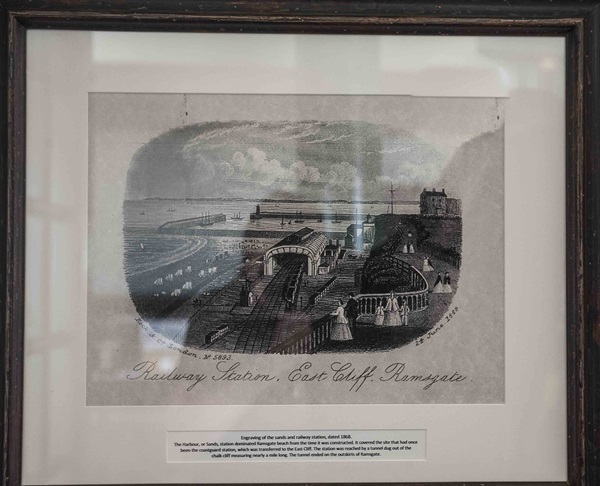
The text reads: The Harbour, or Sands, station dominated Ramsgate beach from the time it was constructed. It covered the site that had once been the coastguard station, which was transferred to the East Cliff. The station was reached by a tunnel dug out of the chalk cliff measuring nearly a mile long. The tunnel ended on the outskirts of Ramsgate.
An illustration of Ramsgate from Punch magazine.
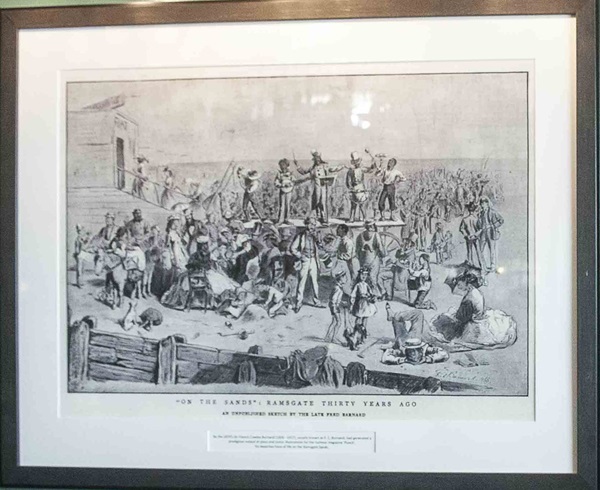
The text reads: By the 1870s Sir Francis Cowley Burnard (1836-1917), usually known as FC Burnard, had generated a prodigious output of plays and comic illustrations for the humour magazine Punch, his depiction here of life on the Ramsgate Sands.
An illustration of Ramsgate from the sea.
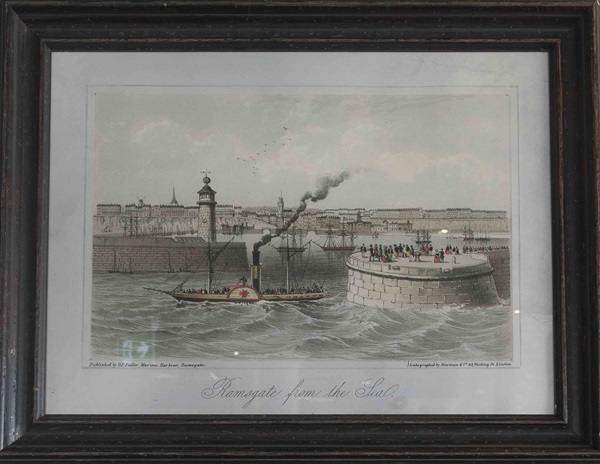
A painting entitled Room Overlooking the Harbour, c1877, by James Tissot (1836- 1902).
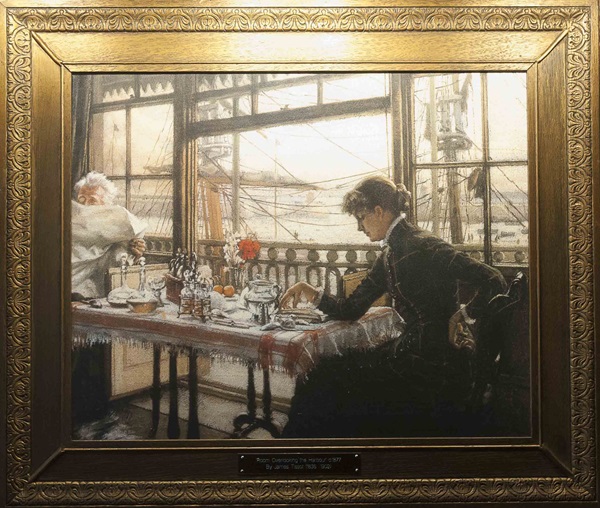
An etching of Ramsgate from the Pier, c1808.
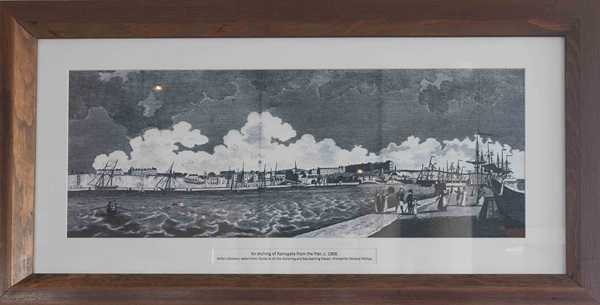
Artist unknown, taken from ‘Guide to all the Watering and Sea-bathing Places’; Printed for Richard Phillips.
An illustration entitled The Pleasures of a wet day in Ramsgate, illustrated for the 1923 Ramsgate Street directory.
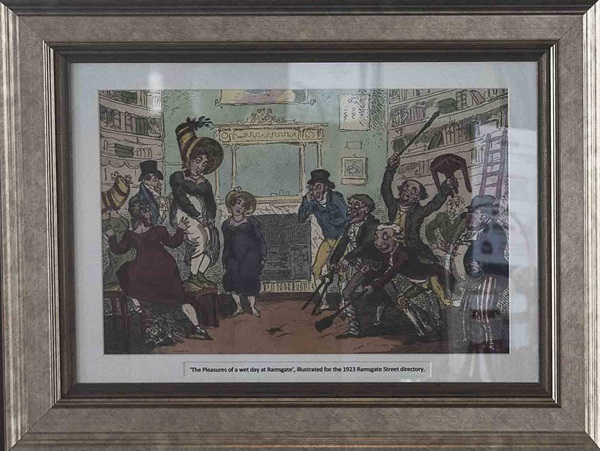
A painting and text about Queen Victoria.
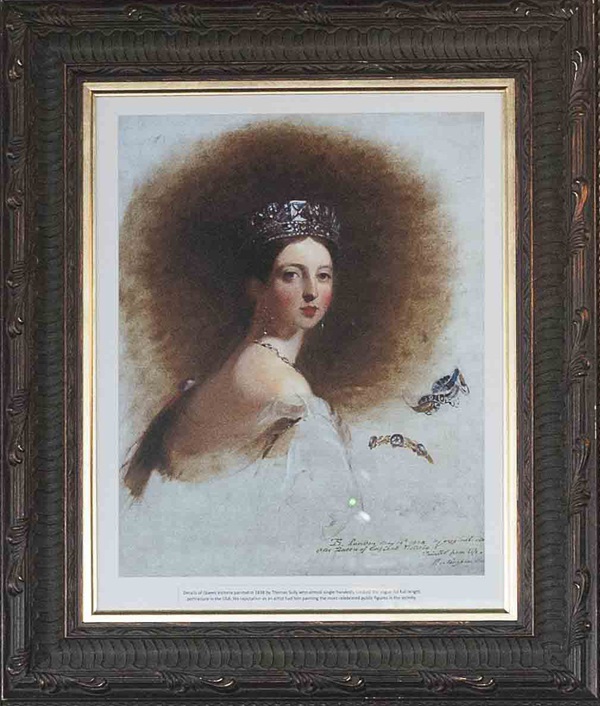
The text reads: Details of Queen Victoria painted in 1838 by Thomas Sully who almost single-handedly created the vogue for full-length portraiture in the USA. His reputation as an artist had him painting the most celebrated public figures in the vicinity.
A painting of Prince Albert, painted for Queen Victoria by John Partridge in 1840.
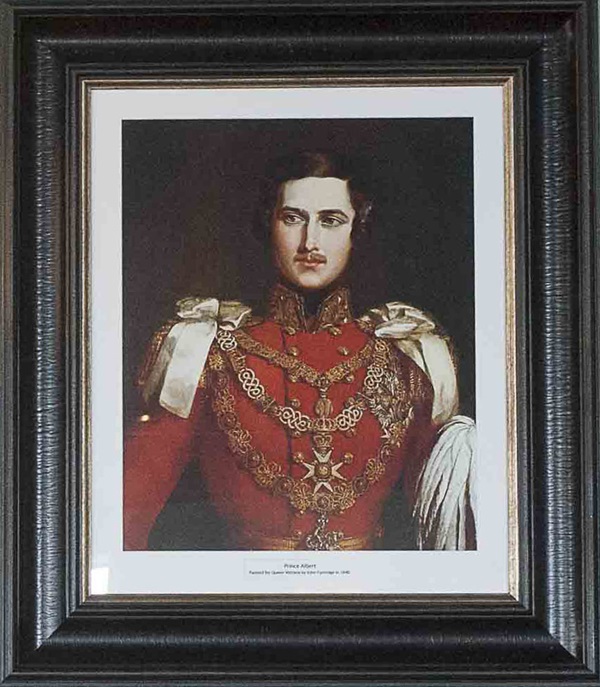
An illustration of Princess Louise, Duchess Of Argyll, c1871.
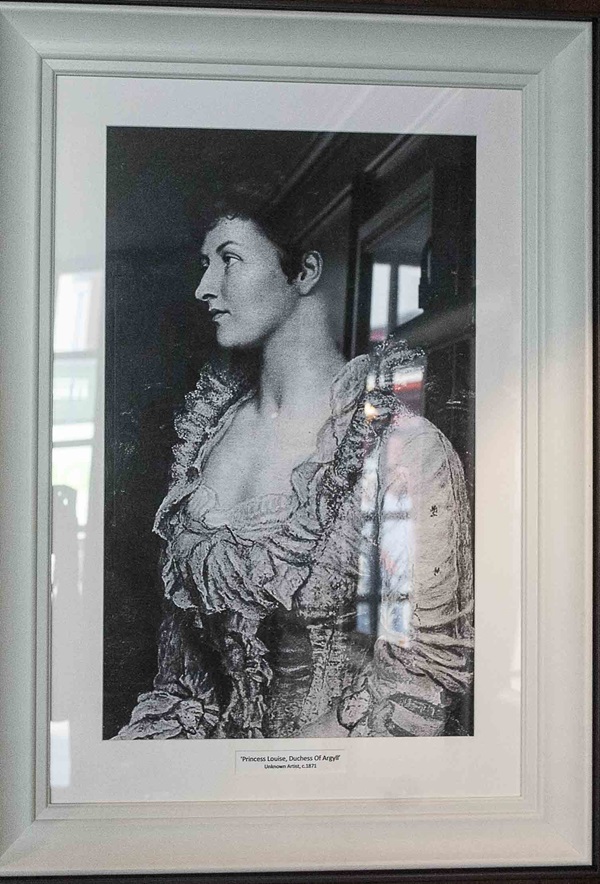
Photographs and text about Will Hay.
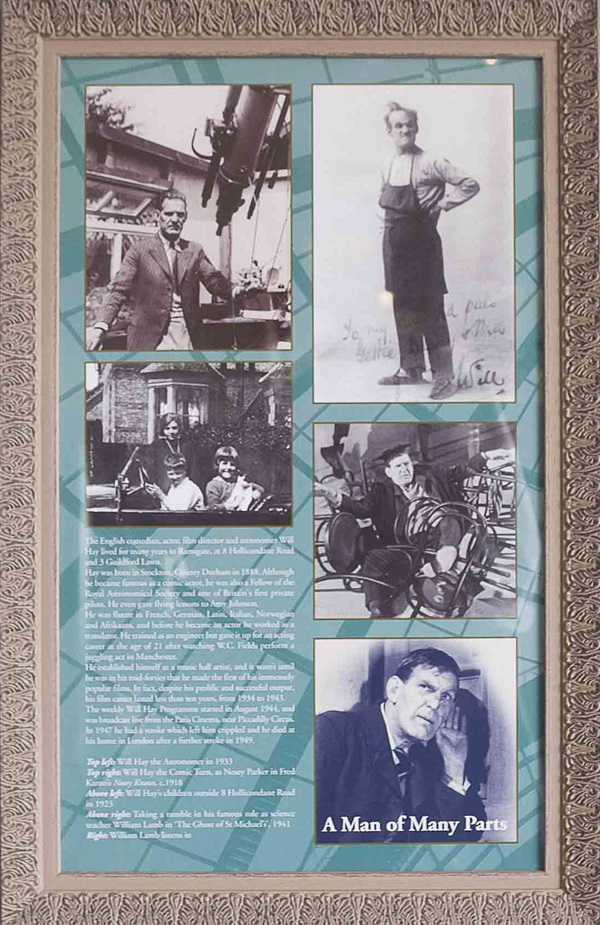
The text reads: The English comedian, actor, film director and astronomer Will Hay lived for many years in Ramsgate at 8 Hollicondane Road and 3 Guildford Lawn.
Hay was born in Stockton, County Durham in 1888. Although he became famous as a comic actor, he was also a Fellow of the Royal Astronomical Society and one of Britain’s first private pilots. He even gave flying lessons to Amy Johnson.
He was fluent in French, German, Latin, Italian, Norwegian and Afrikaans, and before he became an actor he worked as a translator. He trained as an engineer but gave it up for an acting career at the age of 21 after watching WC Fields perform a juggling act in Manchester.
He established himself as a music hall artist, and it wasn’t until he was in his mid forties that he made the first of his immensely popular films. In fact, despite his profile and successful output, his film career lasted less than ten years, from 1934 to 1943. The weekly Will Hay Programme started in August 1944 and was broadcast live from the Paris Cinema, near Piccadilly Circus. In 1947 he had a stroke which had left him crippled and he died at his home in London after a further stroke in 1949.
Top left: Will Hay the Astronomer in 1933
Top right: Will Hay the Comic Turn, as Nosey Parker in Fred Karno’s Nosey Knows, c1918
Above left: Will Hay’s children outside 8 Hollicondane Road in 1923
Above Right: Taking a tumble in his famous role as science teacher William Lamb in The Ghost of St Michaels, 1941
Right: William Lamb listens in.
Photographs and text about Frank Muir.
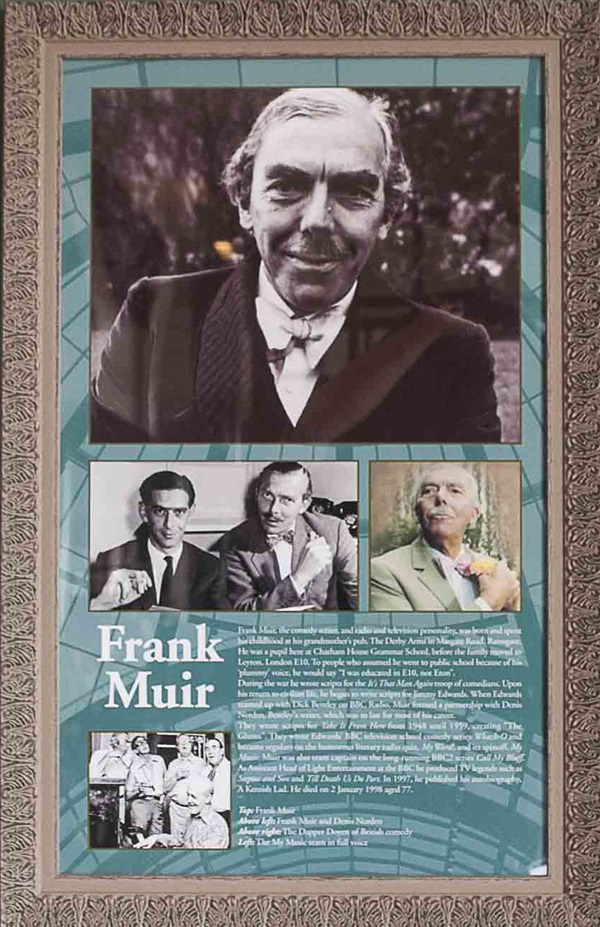
The text reads: Frank Muir, the comedy writer, and radio and television personality, was born and spent his childhood at his grandmother’s pub, The Derby Arms in Margate Road, Ramsgate. He was a pupil here at Chatham House Grammar School, before the family moved to Leyton London E10. To people who assumed he went to public school because of his ‘plummy’ voice he would say, “I was educated in E10 not Eton”.
During the war he wrote scripts for the It’s That Man Again troop of comedians. Upon his return to the civilian life, he began to write scripts for Jimmy Edwards. When Edwards teamed up with Dick Bentley on BBC Radio, Muir formed a partnership with Denis Norden. Bentley’s writer, which was to last for most of his career.
They wrote scripts for Take It From Here from 1948 until 1959, creating The Glums. They wrote Edwards’ BBC television school comedy series Whack-O and became regulars on the humorous literary radio quiz, My Word!, and its spinoff, My Music. Muir was also team captain on the long-running BBC2 series Call My Bluff. As assistant Head of Light Entertainment at the BBC he produced TV legends such as Steptoe and Son and Till Death Us Do Part. In 1997, he published his autobiography, A Kentish Lad. He died on 2 January 1998 aged 77.
Top: Frank Muir
Above left: Frank Muir and Denis Norden
Above right: The Dapper Doyen of British comedy
Left: The My Music team in full voice.
Photographs and text about John Le Mesurier.
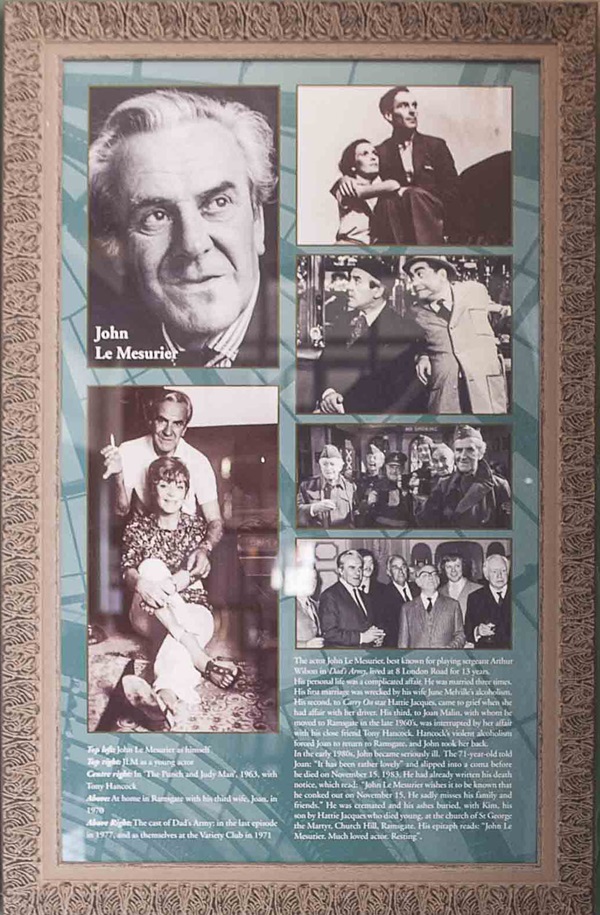
The text reads: The actor John Le Mesurier, best known for playing sergeant Arthur Wilson in Dad’s Army, lived at 8 London Road for 13 years.
His personal life was a complicated affair. He was married three times. His first marriage was wrecked by his wife June Melville’s alcoholism. His second, to Carry On star Hattie Jacques, came to grief when she had affair with her driver. His third, to Joan Malin, with whom he moved to Ramsgate in the late 1960s, was interrupted by her affair with his close friend Tony Hancock. Hancock’s violent alcoholism forced Joan to return to Ramsgate, and John took her back.
In the early 1980s John became seriously ill. The 71 year old told Joan: “It has been rather lovely” and slipped into a coma before he died on November 15, 1983. He had already written his death notice which read: “John Le Mesurier wishes to be known that he conked out on November 15. He sadly misses his family and friends”. He was cremated and his ashes buried, with Kim, his son by Hattie Jacques who died young, at the church of St George the Martyr, Church Hill, Ramsgate. His epitaph reads: 2John Le Mesurier. Much loved actor. Resting”.
Top left: John Le Mesurier as himself
Top right: JLM as a young actor
Centre right: In ‘The Punch and Judy Man’ 1963 with Tony Hancock
Above: At home in Ramsgate with his third wife, Joan in 1970
Above right: The cast of Dad’s Army in the last episode in 1977, and as themselves at the Variety Club in 1971.
Illustrations, prints and text about artists in residence.
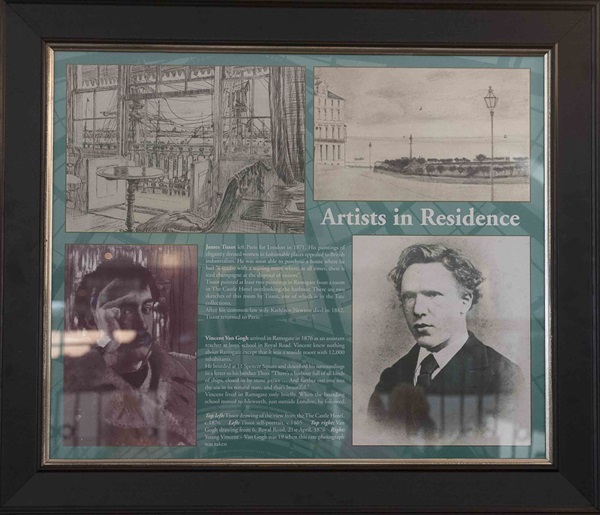
The text reads: James Tissot left Paris for London in 1871. His paintings of elegantly dressed women in fashionable places appealed to British industrialists. He was soon able to purchase a house where he had “a studio with a waiting room where, at all times, there is iced champagne at the disposal of visitors”.
Tissot painted at least two paintings in Ramsgate from a room in The Castle Hotel overlooking the harbour. There are two sketches of this room by Tissot, one of which is in the Tate collections.
After his common-law wife Kathleen Newton died in 1882, Tissot returned to Paris.
Vincent Van Gough arrived in Ramsgae in 1876 as an assistant teacher at boys’ school in Royal Road. Vincet knew nothing about Ramsgate except that is was a seaside resort with 12,000 inhabitants.
He boarded at 11 Spencer Square and described his surroundings in a letter to his brother Theo: “There’s a harbour full of all kinds of ships, closed in by stone jetties… And further out one sees the sea in its natural state, and that’s beautiful”.
Vincent lived in Ramsgate only briefly. When the boarding school moved to Isleworth, just outside London, he followed.
Top left: Tissot drawing of the view from The Castle Hotel, c1876
Left: Tissot self-portrait, c1865
Top right: Van Gogh drawing from 6, Royal Road, 21st April, 1876
Right: Young Vincent Van Gough was 19 when this rare photograph was taken.
A painting entitled Ramsgate Harbour, c1927 by Stanislawa de Karlowska.
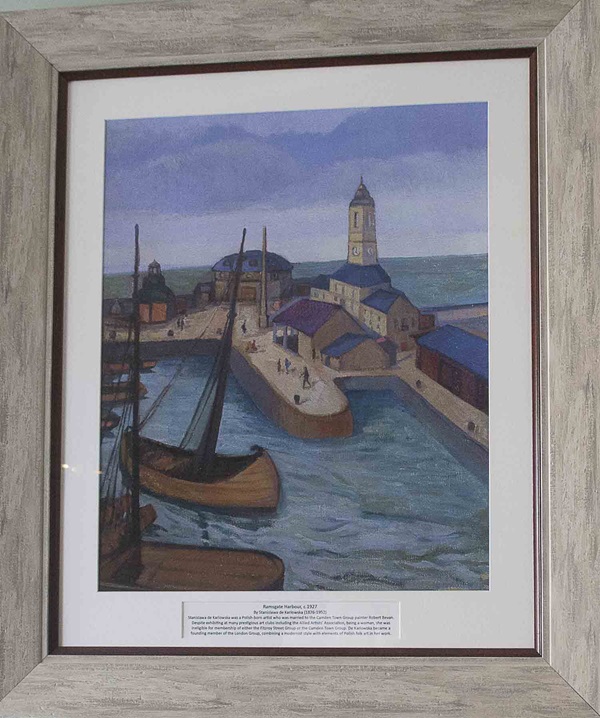
The text reads: Stanislawa de Karlowska was a Polish-born artist who was married to the Camden Town Group painter Robert Bevan. Despite exhibiting at many prestigious art clubs including the Allied Artists’ Association, being a woman, she was ineligible for membership of either the Fitzroy Street Group or the Camden Town Group. De Karlowska became a founding member of the London Group, combining a modernist style with elements of Polish folk art in her work.
An oil painting entitled Manet, by David Mullett.
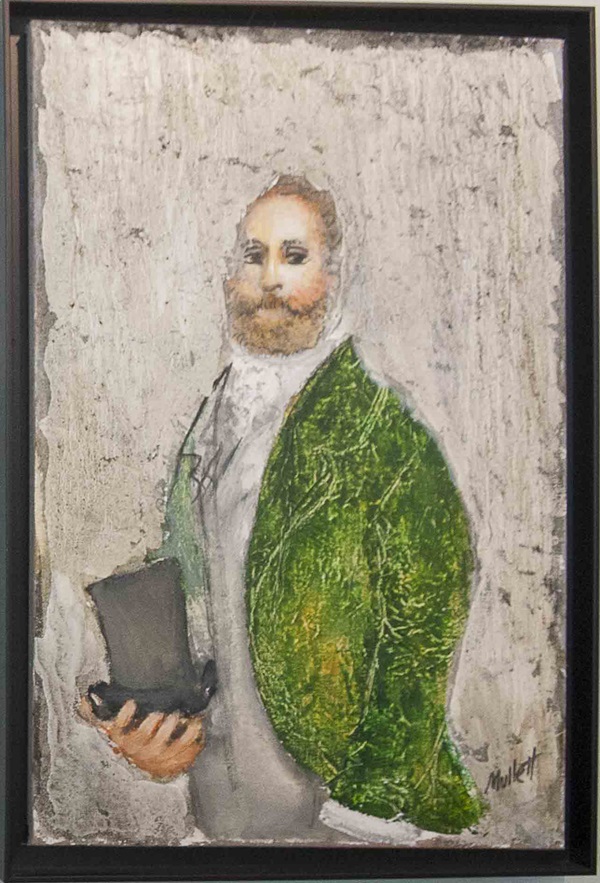
David Mullett studied painting and drawing at the studio of Sir Hubert von Herkomer, German born British painter and pioneering film-director and composer. Progressing in his field, Mullet painted the alter-piece for the Parish Church of Saint Pauline in Quebec and went on to decorate the Cathedral of Notre Dame at Montreal. This portrait of Edouard Manet, a forerunner or the Impressionist movement, was purchased from the Pie Factory Gallery in Margate.
A painting entitled Towards Ramsgate, by Leise Wilson.
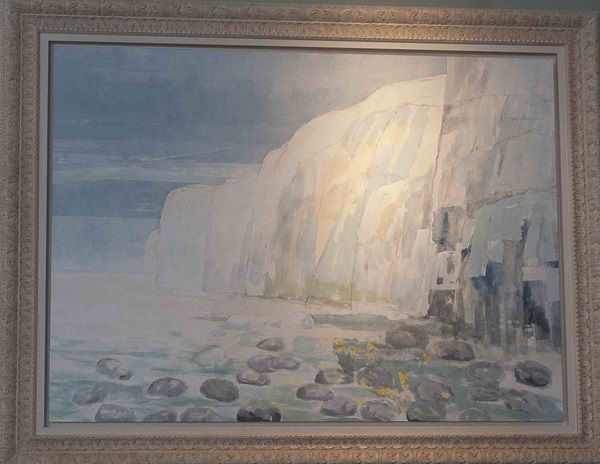
Leise Wilson spent much of her childhood by the Kent coast where she has strong family connections, and she recently returned to live and work here. Walking her dog along local beaches in all weathers and seasons provides the inspiration for her large scale watercolour paintings.
She works in a very individual way, painting onto tissue paper that is then pasted down in translucent layers.
Wilson visits and revisits a site over days, weeks, even months; not only is her experience of the landscape very direct, it is also patient. She finds equivalents in her work to the sensation of ‘being there’. Water, salt, and stain are used to render sea and sand, while bleach echoes the sun’s work on the white cliffs and the effect is has on the volatile skies.
External photographs of the building.
.jpg?h=401&&w=600&la=en&hash=6E53EB448B7B1CB164111568EDE57A78C5F80B0D)
.jpg?h=379&&w=600&la=en&hash=D7D161417332B276653DA08060894C0D2F8EF28E)
If you have information on the history of this pub, then we’d like you to share it with us. Please e-mail all information to: pubhistories@jdwetherspoon.co.uk